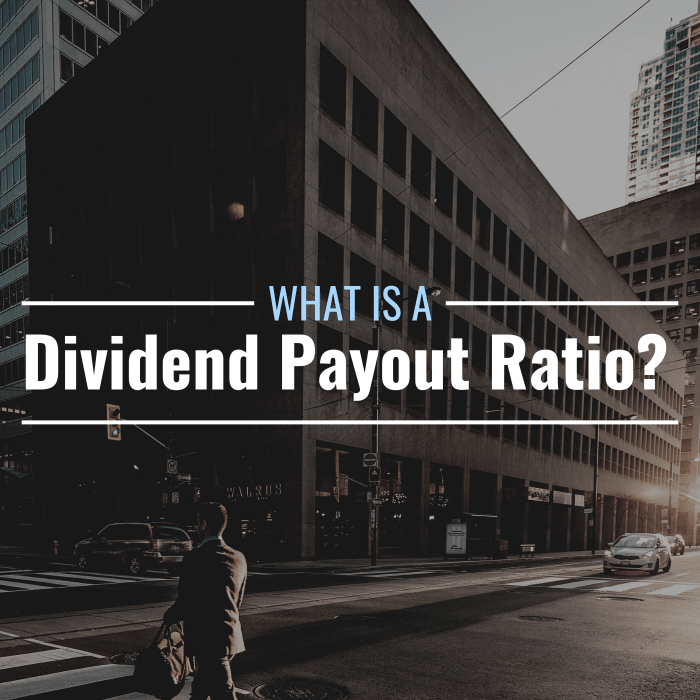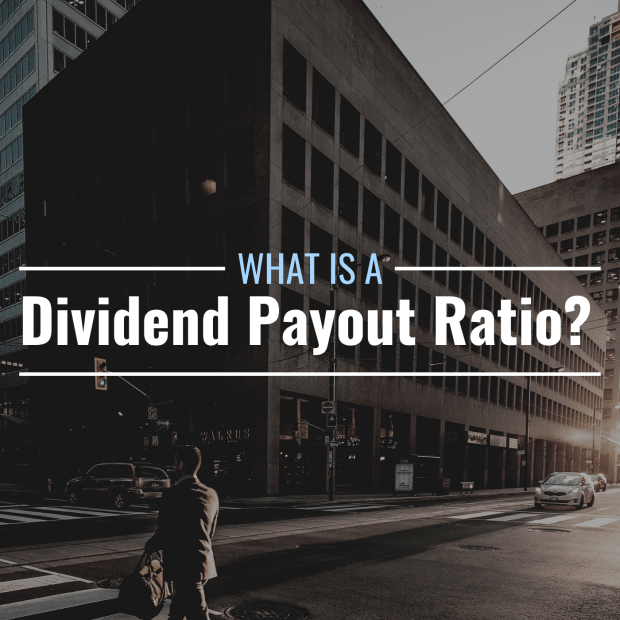https://www.thestreet.com/dictionary/d/dividend-payout-ratio

The dividend payout ratio expresses dividends paid as a percentage of total earnings for a given period.
What Is the Dividend Payout Ratio and What Does It Tell You?
A company’s dividend payout ratio is the ratio of the dividends paid to shareholders over a given period to the company’s earnings for the same period. In other words, it is the percentage of a company’s net income that it pays out to shareholders as dividends.
Earnings that are not paid out as dividends are typically used to finance a company’s ongoing operations (e.g. pay off debt, hire staff, build new plants, repair equipment, etc.), so a company’s dividend payout ratio can be thought of as the ratio of income it distributes to its investors vs. income it reinvests in its own operations.
The opposite, so to speak, of the dividend payout ratio is the retention ratio. This is the ratio of income that is retained for business operations to total income. If a company has positive earnings and does not pay dividends, its retention ratio would be 1 (or 100%).
How Do You Calculate a Company’s Dividend Payout Ratio?
There are a couple of ways to calculate a company’s payout ratio. For a specific period, divide the value of all dividends paid by a company’s net income. Alternatively, divide a company’s dividends per share by its earnings per share.
Dividend Payout Ratio Formula 1
DPR = Total Dividends Paid / Net Income
Dividend Payout Ratio Formula 2
DPR = Dividends per Share / Earnings per Share
Dividend Payout Ratio Example: Coca-Cola Co. (NYSE: KO)
Let’s take a look at the Coca-Cola Company’s dividend payout ratio for 2021. For this example, we’ll use the second formula listed above.
Coca-Cola paid a quarterly dividend of $0.42 per share during the 2021 year. This makes for a total of $1.68 worth of dividends paid for each outstanding share over the course of the year. Coca-Cola reported earnings of $2.25 per share for that year.
DPR = Dividends per Share / Earnings per Share
DPR = $1.68 / $2.25
DPR = 0.7466 or 74.66%
So, it looks like Coca-Cola used about 74.66 percent of its 2021 earnings to reward shareholders with dividend payments while retaining about 25.33% of income to finance its ongoing business operations. This is fairly normal for a successful, mature, blue-chip company like Coca-Cola.
Dividend Payout Ratio vs. Dividend Yield: What’s the Difference?
Dividend yield is calculated by dividing the dividends paid by a company over the last year by its current share price.
So, while dividend payout ratio compares dividends to earnings, dividend yield compares dividends to stock price, which varies constantly and is not necessarily reflective of a company’s real value. A sudden slide in stock price, therefore, can inflate dividend yield rapidly despite dividend payments remaining unchanged. If a stock’s price skyrockets, on the other hand, dividend yield can shrink quickly.
Scroll to Continue
TheStreet Dictionary Terms
For this reason, dividend payout ratio is probably a more informative measure. Since EPS, rather than stock price, serves as the calculation’s denominator, changes in share price due to macroeconomic factors and market sentiment do not distort the ratio.
Whether a company’s stock is skyrocketing, plummeting, or remaining somewhat stable, its dividend payout ratio gives you a clear picture of the percentage of its earnings it tends to distribute to shareholders as dividends.
What Is a Good Dividend Payout Ratio?
What an investor considers a “good” DPR varies depending on their investment goals. A growth-oriented investor interested in tech startups might see a high payout ratio as troubling, since newer companies hoping to grow their market share should probably be reinvesting the bulk of their earnings in growth, hiring, expansion, etc. A fixed-income investor, on the other hand, would likely seek out stocks with payout ratios as high as possible since they prefer passive income to growth.
Different industries have different norms when it comes to dividends, and older, more mature companies tend to use more of their income for dividends than younger companies in growth phases.
What Does a High Dividend Payout Ratio Mean?
A high payout ratio (over 0.5 or 50%, for example) indicates that a company uses more of its earnings to pay shareholders than it does to reinvest in business operations like hiring or research and development. This can be seen as a sign that a business is mature, stable, and successful to a degree that it can comfortably maintain profitability while rewarding investors with substantial dividends on a regular basis.
If a company is posting substandard profits or seems to be losing market share to competition, however, a high payout ratio could be seen as a sign of mismanagement. If profits and market share aren’t secure, most investors would prefer to see a company double down on maintaining a competitive edge than passing dwindling earnings on to shareholders.
Certain types of businesses, like REITs (real estate investment trusts), are required to distribute at least 90% of their net income to shareholders as dividends, so all REITs have a DPR of at least 0.9 (90%).
What Does a Low Dividend Payout Ratio Mean?
A low dividend payout ratio indicates that a company is retaining most of its earnings to use for things like expansion, product development, and marketing. For younger, growing businesses, this is normal and healthy. Growth investors who favor new, innovative companies would rather see their shares go up in value over time than receive quarterly or annual payouts.
If, however, a mature company known for paying dividends consistently suddenly lowers its ratio, this could be a sign of financial trouble—profits may be sliding, and the company may be diverting more of its earnings to things like advertising and product improvements in an effort to regain lost market share.
Average Dividend Payout Ratios by Industry
| Industry | Average Payout Ratio |
|---|---|
|
Apparel |
29.27% |
|
Auto |
2.79% |
|
Banks (Regional) |
26.08% |
|
Construction Supplies |
36.62% |
|
Farming/Agriculture |
18.32% |
|
Green & Renewable Energy |
0.20% |
|
Homebuilding |
5.83% |
|
Metals & Mining |
35.95% |
|
Restaurant/Dining |
47.43% |
|
Semiconductor |
28.94% |
|
Utilities (General) |
80.77% |
Frequently Asked Questions (FAQ)
Below are answers to some of the most common questions investors have about dividend payout ratios that were not already covered in the sections above.
Can a Dividend Payout Ratio Be Negative?
Yes, if a company has negative earnings but still pays dividends, its dividend payout ratio is negative. For instance, if a company had an EPS of -$1.23 and paid $0.38 in dividends that year, it would have a DPR of -0.03 or -3%.
Can a Dividend Payout Ratio Be More than 1 (or 100%)?
Yes, occasionally, companies’ earnings drop but they are reluctant to lower dividends. In these cases, some companies end up paying more in dividends than they actually earn for a given period, and when this occurs, DPR can be over 100%. For instance, if a company paid $2.00 in dividends but posted an EPS of only $1.95, its payout ratio would be 1.02 or 102%.













